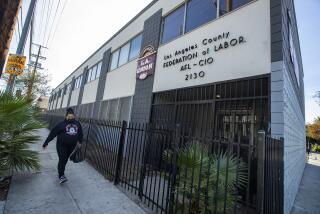A Glimpse at Wiretap Device Central to the Case
- Share via
In a racketeering indictment issued last week, federal prosecutors contend that Hollywood private eye Anthony Pellicano helped develop a device called Telesleuth, which he then used in illegal wiretaps.
Telesleuth was used to convert voice recordings into digital files that could be stored on a computer for easier transcription, according to a spokesman for the U.S. attorney’s office. Prosecutors would provide no other details.
Jill A. Cossman, an attorney with Greenberg, Glusker, Fields, Claman, Machtinger & Kinsella, represented Pellicano in an attempt to trademark Telesleuth in 1995. The application describes the product as “computer hardware and computer software which will be used for the monitoring and/or recording and subsequent playback of telecommunications.”
The application was ultimately abandoned.
Bertram Fields, a prominent entertainment lawyer and partner in the firm, used Pellicano’s investigation services and is a subject of the ongoing federal investigation.
Brian Sun, an attorney representing Greenberg, Glusker, called the idea that trademark attorneys would have known of or condoned criminal uses for Telesleuth “preposterous.”
“It was specifically intended to be marketed to law enforcement officials,” he said.
Pellicano was a high-profile investigator and expert in audio analysis for individuals, law firms and law enforcement agencies in criminal cases. He formerly operated a Los Angeles-based company called Forensic Audio Lab.
Today, recorders that turn spoken words into computer-readable files are inexpensive consumer products. But they were not widely available in 1995, when Pellicano allegedly hired software developer Kevin Kachikian to produce Telesleuth.
“I’d guess that Telesleuth was pretty low-tech, perhaps a self-contained digital voice recorder that could be physically attached to a phone line in the field,” said Phil Karn, a telecom security expert in San Diego. “A well-designed device could draw what little power it needs from the phone line without needing a battery that would have to be replaced.”
Experts said a sophisticated programmer could easily have set Telesleuth to decode the touch tones of the target’s dialed numbers or to read incoming numbers detected by caller-ID services.
Kachikian pleaded not guilty to several charges in the Pellicano case, including destruction of computer files, hardware and software related to Telesleuth. He is free on $100,000 bail. Neither he nor his attorney returned calls seeking comment.
Kachikian’s personal website features two products designed for Pellicano: Forensic Image Sleuth and Forensic Audio Sleuth, described as tools to verify the authenticity of image and sound files. Pellicano holds a trademark for Forensic Audio Sleuth.
In the 1990s, Kachikian also briefly worked as a consultant for the Los Angeles Times, producing software that enabled Macintosh computers to download weather data.
According to the indictment, Telesleuth was housed in a case Pellicano ordered from Philadelphia-based Amuneal Manufacturing Corp., which specializes in containers that block electromagnetic emissions. The case was designed to prevent interference from power lines, which are often near phone-switching boxes.
“A shielded case would avoid causing noise on telephone circuits, noise that would be annoying enough that someone would call the phone company to complain,” said Steven M. Bellovin, a computer scientist at Columbia University and former security researcher at Bell Labs. “That sort of investigation — purely technical, not for fear of wiretaps — would likely uncover the box.”
Pellicano never told Amuneal why he wanted the cases, but ordered 24, said Jim Flannagan, a sales manager for the company. Flannagan said he vividly recalled the 6-year-old order, because Pellicano became incensed when the job was delayed a day. “He went ballistic” in a phone conversation, Flannagan said. “He called me a liar. I just hung up.”
Experts said the alleged taps could have been placed inside the phone company computer system, outside the subscriber’s home or office, or on phone lines in several locations between those points.
In the Pellicano case, the government described insider access as a key step. Field technician Rayford Earl Turner, who retired from SBC — now called AT&T — in 2001, allegedly obtained subscriber data on Pellicano’s targets from Teresa Wright, a sales support manager with SBC, California’s largest local phone company.
Wright worked in the company’s Wilshire Boulevard office until she was fired in November 2003. She pleaded guilty to fraud associated with Pellicano’s alleged wiretaps.
*
Times staff writer Andrew Blankstein contributed to this report.
More to Read
Sign up for Essential California
The most important California stories and recommendations in your inbox every morning.
You may occasionally receive promotional content from the Los Angeles Times.













